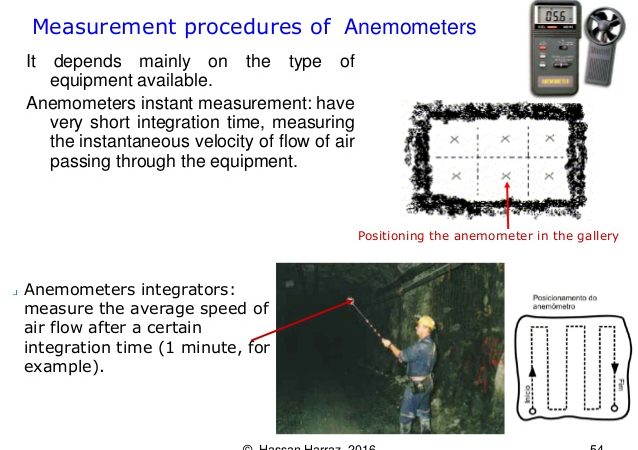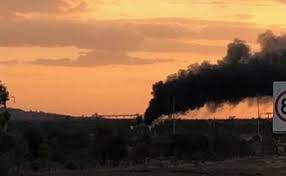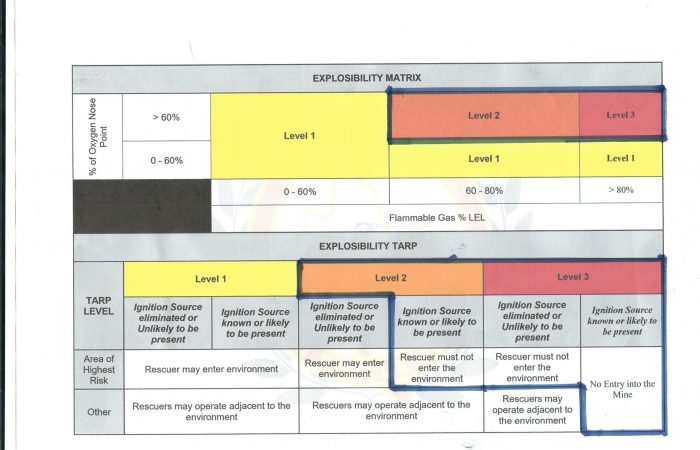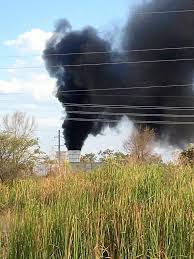
North Goonyella 9Nth MRE 31st August 2017. Inspector Marlborough “In LW 9 Nth noticed that the ventilation station at the outbye end of the Maingate travel road was situated in the centre of an area where stonedust “Bat Bags” were installed. I suggested that the Ventilation Officer should check the cross sectional area used on the board and whether it takes into account the presence of the Bat Bags. I also suggested that this is not the ideal place for the location of a ventilation station.”
MRE – North Goonyella – 31.08.2017.pdf
Inspector attends the Mine to conduct a routine Inspection of North Goonyella.
At the end of the Mine Record Inspector includes two (2) recommendations
- Review of ERZ Controller’s Inspection SOP
- Strata Control Defect Management Due date 4th October 2017
In the 9Nth Longwall Inspector Marlborough notes major problems with the location of a Section Ventilation Station was situated in the centre of an area where stonedust “Bat Bags” were installed.
This a complete failure of the specifications about the roof and rib conditions and obstructions for locating Ventilation Stations.
The Ventilation Officer is responsible for deciding the location of the Ventilation Stations and ,making use of the readings.
How this can have occurred is just beyond reasonable explanation with velocity readings taken each shift by ERZ Controller
This is supposed to be part of Mine Ventilation and Monitoring 101 for the Ventilation Officers.
If the air velocity, cross sectional area and therefore the quantity of ventilation is not reliable and repeatable, then there is little information that relies on these basic parameters that can be relied on
Again in my opinion this openly demonstrate that North Goonyella either took only token/no action or just basically ignored the MRE and Findings of Inspector Brown.
9 Nth 2nd workings Audit PB sept 2016
I noticed that the ventilation station at the outbye end of the Maingate travel road was situated in the centre of an area where stonedust “Bat Bags” were installed. I suggested that the Ventilation Officer should check the cross sectional area used on the board and whether it takes into account the presence of the Bat Bags. I also suggested that this is not the ideal place for the location of a ventilation station.
I just point out the following comments in the September 2017 Paul Brown MRE
As a general comment for the whole of the Risk Assessment (RA), any references made to a site Standard, Procedure, MOP, TARP, PHMP or SOP must have the full document name recorded within the RA details.
Reference made throughout the Risk Assessment to ‘Atmospheric Monitoring’ must be specific for each situation, i.e. hand held instrument, tube bundle, real
4 Section 3.5, “Ventilation pressures are set-up to as low as practicable with the aim of maintaining low differential pressures across both active and previous goaves Is this TARP driven for triggers? if not, why not?
Section 3.5, detail based on known history from Longwall 8N extraction on volumes of gas extraction would be of benefit to this section.
Section 3.5, ventilation modelling detail for Sewer Bleed detail required.
In the MG 10N Panel “ there was a 20/30 m section of road, up to a set of air doors where it was apparent that the roof and sides had never been treated with stonedust. Mr Young agreed to rectify this.”
I noted that the window Deputy had not completed an inspection nor had he countersigned the Night Shift ERZ Controller’s Stat Report. I later had a discussion with this ERZ Controller who explained to me that an inspection was not due as per the Mines Inspection SOP and that he covered his inspection of the face area on his Outbye Inspection report which was kept elsewhere. I reminded the ERZ Controller that, when he takes over an inspection District, he must read and countersign the previous ERZ Controller’s inspection report. The ERZ Controller explained that when he started that morning the Night Shift ERZ Controller had not completed writing his report.
I recommend that the mine review the Inspection SOP to ensure that it effectively deals with the inspections required by the “window” Deputies who take control of production districts between the end of Night Shift and the start of Day Shift.
I, Mr Leslie Marlborough, Inspector of Mines conducted an inspection of the mine. I was met at the mine on arrival by Mr Mike Carter, SSE
Opening Meeting
Attended by Mr Carter, Mr Jason Klein, Longwall Superintendent (Acting), Mr Shane Fleming, Engineering Manager and Mr John Deacon, Development Superintendent.
Mr Carter gave me a very thorough update on the current status of the mine. The current safety statistics at the mine were very encouraging with a TRIFR of 1.19 (measured on the Peabody system), and the mine had gone 1 year LTI free.
LW9 North is currently at 1400 chainage and is producing well with good conditions being experienced on the face. Development is commencing to drive MG 10 North and is currently at approximately 2 CT. Mr Carter explained the long term plans for the mine with the next Longwall blocks following 9 North to be 10 North then changing over to the other side of the mine to work 10 South, then 9, 8, 7 and 6 South. •
I discussed recent incidents in the industry including the recent fatality at Goonyella Riverside and the potential implications for similar work that may be carried out at N01th Goonyella. Mr Fleming stated that he had looked at any similar tasks that may be occurring at the mine and any future works of a similar nature would be risk assessed using the information that is known from the Goonyella Riverside incident.
Mr Carter then explained the status of the mine’s goaf drainage system. Currently had 4 blow skids available (each with a capacity of around 1200 1/s) and 2 gas engines (each with a capacity of 1500 1/s), which gives a total capacity of approximately 3,000 1/s. Goafholes are spaced at 50 m intervals and for the past few weeks the goaf drainage is effectively managing the TG gas levels.
Mr Carter showed pictures of the purpose made platform that the mine has had manufactured to allow secondary support work to be undertaken over the LW MG conveyor. This will be introduced shortly to the mine.
Underground Inspection
Before going underground I visited the control room. The control room operator was aware of what activities were going on around the mine. He was aware of any gas monitoring alarms that were active and an examination of the gas alarm log showed that the alarms were being recorded to a good standard, with clear actions taken recorded and the name of the person to who the alarm was notified.
Examining the Methane trends for the LW 9 North TG Methane monitor showed that, although there had been several occasions where there had been Methane spikes over 2.0% there were no occasions where Methane had exceeded 2.5%.
I read the ERZ Controller’s Statutory reports for the previous 24 hours. These were completed to a reasonable standard and were readily available for coal mine workers to observe.
I was accompanied underground by Mr Carter, Mr Terry Young, (Development Coordinator), Mr Klein and Mr Tony Cook (Undermanager). While in the outbye areas of the mains I observed a Driftrunner and the operator was not wearing his safety helmet or his seat belt. I had a discussion with the operator regarding his section 39 obligations for complying with the Act and the SHMS. The operator put his helmet on and his seat belt and Mr Carter took note of the incident to deal with and communicate to the workforce.
I noted that there were many areas where there was damaged rib support in the mains. Some was marked with hazard or no road tape and some was not marked at all. Road conditions and stonedust standards were acceptable throughout and I noted that there was very little dust raised as we drove in, which greatly assists in controlling airborne dust in the production panels.
MG 10N
ERL Controller was Mr Clinton Cole. At the point where we parked the Drift-runner there was a 20/30 m section of road, up to a set of air doors where it was apparent that the roof and sides had never been treated with stonedust. Mr Young agreed to rectify this.
The crib room standards were good. The notices and procedures hung around the crib room were clean and appeared to be up to date. I asked who the ERZ Controller was and was told Mr Cole had taken over from the “window Deputy”. I noted that the window Deputy had not completed an inspection nor had he countersigned the Night Shift ERZ Controller’s Stat Report. I later had a discussion with this ERZ Controller who explained to me that an inspection was not due as per the Mines Inspection SOP and that he covered his inspection of the face area on his Outbye Inspection report which was kept elsewhere. I reminded the ERZ Controller that, when he takes over an inspection District, he must read and countersign the previous ERZ Controller’s inspection report. The ERZ Controller explained that when he started that morning the Night Shift ERZ Controller had not completed writing his report.
I recommend that the mine review the Inspection SOP to ensure that it effectively deals with the inspections required by the “window” Deputies who take control of production districts between the end of Night Shift and the start of Day Shift.
The panel transformer was installed to a high standard. The stub was well stonedusted and adequately supported. All equipment was in place and the signage was clean, legible and easily read.
We went to continuous miner CM 10 an ABM machine. The miner was in production at the time of inspection and the wheeling road was in an acceptable condition. I noted that there were many rib bolts, particularly on the LHS of the miner that showed excessively long bolt tails. It was explained to me that the LH rib always gave problems with the installation of rib bolts due to the holes collapsing before the bolts can be installed. I was told that the Geotechnical people do an audit weekly. I had a discussion with the CM operator. Roof conditions were good and the roof support was installed to a high standard. The operator explained the controls in place for respirable dust and it was a mine site requirement for all persons on the CM to wear dust masks whenever the miner was in production.
LW9 North
We next visited LW9 North which was on production at the time of inspection. The ERZ Controller was Mr David Brown
I noticed that the ventilation station at the outbye end of the Maingate travel road was situated in the centre of an area where stonedust “Bat Bags” were installed. I suggested that the Ventilation Officer should check the cross sectional area used on the board and whether it takes into account the presence of the Bat Bags. I also suggested that this is not the ideal place for the location of a ventilation station.
The Longwall face was in good condition with good roof conditions throughout. The face was straight and the creep was being well managed. Dust suppression sprays all appeared to be functioning correctly but there was still some signs of airborne dust through the face, although this was difficult to determine whether it was dust or water from the mist sprays. There was evidence of dust on the shields but this was wet and not likely to become airborne. I observed two coal mine workers engaged in hosing down shields on the MG side of the shearer. I had a conversation with several coal mine workers. They were all aware of the dust controls on the face and they all stated that, whenever people had to go TG side of the shearer to do things like “double Chocking” the shearer was stopped before they went TG side of the shearer. I had a discussion with two
‘inexperienced” mine workers (wearing yellow helmets) and their Mentors. All were very familiar with the role of the mentor and could explain the process for effectively managing the inexperienced mine workers. Both inexperienced mine workers were able to tell me what their emergency Escapeways were and where there caches and escape/emergency equipment was located.
At the Maingate end of the face, approximately 30 m outbye of the face, alongside of the BSL I observed about 6 rib bolts (top bolts) with excessive bolt tails. This rib did not exhibit any signs of fretting which could explain the poor standard of bolt installation as was observed in the development panel.
Close Out Meeting
Attended by Mr Carter, Mr Jason Klein, Mr Shane Fleming, Mr Gavin Shields, Safety
Manager, Miss Ashley O’Reilly, Geologist and Mr Jamie Haartz Production Manager.
Mr Shields gave a presentation on the mine’s last two quarters of respirable dust results. There had been no exceedances during the period and most of the results had been below 1.5 mg/m . The mine is to be congratulated on these results and demonstrates a positive outcome for the work that has been carried out at the mine to reduce dust exposure. The mine’s Respirable Dust Management Plan and sampling schedule have been correctly endorsed in line with Recognised Standards by a Registered Occupational Hygenist.
We had a discussion regarding the points noted during the underground inspection. We discussed the damaged rib support and the defective rib support. We discussed the mine’s system for auditing and prioritising defective support. I also raised my concerns regarding the use of hazard tape or no road tape attached to rib mesh to denote a hazard. The tape and its position needs to reflect the nature of the hazard and the need to form an effective barricade to protect coal mine workers from the hazard.
I will issue a recommendation that the mine reviews its process for mapping installed support and the identification of incorrectly installed primary and secondary support and any resulting remedial works. This review should also include the development of a barricading standard for the highlighting of identified defective support in outbye areas (as opposed to simply using red and white tape tied to rib mesh) and a method of prioritising remedial works.
We had a discussion about the “window Deputies” and what is required for them with regards inspections and reports etc. I will issue a recommendation for the mine to review their Inspections SOP to ensure that it covers what is required for the ERZ coverage for production and other districts during the daily window between night shift and day shift.
I thanked Mr Carter and his team for their openness and the frank discussions that we had.
Recommendations
Review of ERZ Controller’s Inspection SOP
Recommend that the mine conduct a review of the Inspection SOP to ensure it adequately covers the requirements for inspection requirements for the ERZ Controllers in the window between night shift and day shift when taking control of the activities in production districts.
Provide a response to this recommendation by 4 October 2017
Strata Control Defect Management
Recommend that the mine reviews its process for mapping installed support and the identification of incorrectly installed primary and secondary support including damaged support in outbye areas and any resulting remedial works that may be required. This review should also include the development of a barricading standard for the highlighting of identified defective support and a method of prioritising remedial works.
The mine to provide a response to this recommendation by October 4 2017.
Please provide a written status report on each SCP together with the actions taken to address each item by their due dates
Please provide a written status report on each Directive together with the actions taken to address each item by their due dates
Please provide a written status report on each Directive and SCP together with the actions taken to address each item by their due dates


